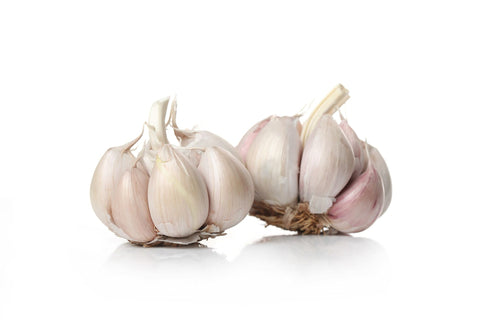Preclinical and clinical studies reveal a close relationship between dietary habits and the occurrence of disease. Diet high in saturated fat may increase the risk of heart disease and some forms of cancer.
On the other hand, diet rich with fruits, vegetables and herbs reduces risks and may even prevent some diseases. Garlic (Allium sativum), in particular, is considered to be one of the best disease-preventive foods because of its numerous health benefits. It has been traditionally employed to treat infection, colds, diabetes, heart disease, and a host of other disorders.
Clinically, it has been evaluated for lowering blood pressure, cholesterol, and glucose concentration, as well as for the prevention of cognitive decline and cancer.
The Chemistry of Garlic
Intact garlic bulbs contain high amounts of g-glutamylcysteines. These compounds can be hydrolysed and oxidized to form alliin. After processing, such as cutting, crushing, chewing or dehydration, an enzyme called alliinase rapidly lyses the alliin to form allicin.

Despite being known as strong anti-bacterial and anti-viral agent, allicin is unstable and instantly decomposes to other compounds, such as diallyl sulphide (DAS), diallyl disulphide (DADS), diallyl trisulphide (DAT), dithiins and ajoene.
G-glutamylcysteines are also converted to S-allylcysteine (SAC) via pathway other than the alliin/allicin pathway. SAC is one of the water-soluble organosulfur compounds in garlic, and its concentration increases during garlic extraction. SAC is the most active bioavailable compound in garlic and is a major contributor to garlic’s health benefits.

Figure 1. Chemical changes in garlic (Amagase et al., 2001).
Garlic is also rich in other compounds such as: steroidal glycosides, lectins, prostaglandins, fructan, pectin, essential oil, adenosine, vitamins B1, B2, B6, C and E, biotin, nicotinic acid, fatty acids, glycolipids, phospholipids, anthocyanins, flavonoids, and essential amino acids (Amagase et al., 2001).
Black Garlic vs Raw Garlic
Black garlic, which is basically fermented garlic, is even healthier than raw garlic. Black garlic is produced by allowing raw garlic to age in temperatures between 140–170 degrees for a period of three to four weeks. This triggers a chemical process that occurs between amino acids and reducing sugars. This reaction enhances the nutritional value and gives the garlic a dark colour, chewy texture, and distinct flavour.
Black garlic is significantly higher in phenolic content and has greater anti-oxidant activity; it is also packed with high concentrations of organosulfur compounds, mainly s-allylcycteine (SAC). An advantage of SAC is that it has very high bioavailability, is well-absorbed and much more stable than allicin. Researchers are confident it plays a significant role in garlic's overall health benefits, mainly in the enhancement of immune cells and inhibition of cholesterol activity.
In a study done by Wang et al. (2010), black garlic extract enhanced the cellular immunity by raising the activity of NK (natural killer) cells which are known to play a critical role in eradication of tumour cells in vivo.
In this study, the cytotoxic activity of the NK (natural killer) cells was tested in spleen cells prepared from black garlic extract-treated mice. Wang et al. (2010), treated the mice with the black garlic extract for 5 days, after which the treatment was ceased. The cytotoxic activity of NK cells gradually increased and it reached maximum on day 10, 5 days later after the last injection (Figure 2).

Figure 2. Black Garlic (Allium sativum) extract enhances the immune system (Wang et al., 2010).
Health Benefits of Garlic
Immune boosting effect
Immune cells, especially innate immune cells, are responsible for activating inflammation necessary to kill pathogens. Two innate immune cells such as γδ-T and natural killer (NK) cells are the ones most susceptible to diet modification. Garlic has been demonstrated to have the potential to influence these cells. In a randomized, double-blind, placebo-controlled study, Susan et al. (2016) recruited 120 healthy individuals to determine the effect of consuming 2.56 g garlic extract daily. Capsules were consumed for a total of 90 days and blood samples were taken at the beginning of the study and at day 45 to determine if immune changes had occurred. Susan et al. (2016) concluded that γδ--T cells nearly doubled their ability to proliferate, whereas the NK cells almost tripled their proliferation numbers after the consumption of garlic extract.
Cardiovascular effect
Garlic has been widely recognised effective as both, a preventative agent and in the treatment of many cardiovascular diseases, including atherosclerosis, hypercholesterolemia, and hypertension. Many large-scale randomised trials have demonstrated a graded effect between degree of hypercholesterolemia and garlic intake. In a review done by Xiong et al. (2015), garlic was suggested as an effective and safe approach for hypertension. Xiong et al. (2015) identified seven randomised placebo-controlled trials. Compared with the placebo, all seven trials revealed a significant lowering effect of garlic on both systolic BP (WMD: −6.71 mmHg; 95% CI: −12.44 to −0.99; P = 0.02) and diastolic BP (WMD: −4.79 mmHg; 95% CI: −6.60 to −2.99; P < 0.00001). No serious adverse events were reported in any of the trials (Xiong et al., 2015).
Anti-diabetic effect
Adding black garlic to a healthy and balanced diet is a simple way to maintain normal blood sugar levels. A double-blinded placebo-controlled study published in the journal Acta Diabetologica (2008) was performed to estimate the effects of time-released garlic powder on the parameters of metabolic control and plasma lipids in type 2 diabetes mellitus. The metabolic action of the garlic powder was investigated in 60 type 2 diabetic patients. Fasting blood glucose was measured daily, and serum fructosamine as well as cholesterol and triglyceride levels were determined at the baseline, and after 1, 2, 3 and 4 weeks. This study further demonstrated that treatment with garlic results in better metabolic control due to the lowering of fasting blood glucose, serum fructosamine and serum triglyceride levels. (Sobenin et al., 2008).
Cognitive effect
Research studies have pointed towards the beneficial use of garlic for the improvement of cognitive function in the elderly and Alzheimer’s disease patients. Alzheimer’s disease (AD) manifests with neuro-inflammation and activation of microglia that promote neurodegenerative process through pro-inflammatory cytokines like 1β (IL-1β) and tumour necrosis factor-α (TNFα). A recent study done by Nillert et al. (2017) demonstrated that garlic extract at doses of 250 and 500 mg/kg BW could significantly improve short-term recognition memory in cognitively impaired rats, and minimize the inflammatory response by reducing the activation of microglia and IL-1β.
References
-
Amagase, H., Petesch, B. et al. (2001). Intake of Garlic and Its Bioactive Components. American Society for Nutritional Sciences. 23 (5), 123-134.
-
Sobenin, I.A., Nedosugova, L.V. et al. (2008). Metabolic effects of time-released garlic powder tablets in type 2 diabetes mellitus: the results of double-blinded placebo-controlled study. Acta Diabetologica. 8 (45), 1-6.
-
Nillert, N., Pannangrong, W. et al. (2017). Neuroprotective Effects of Aged Garlic Extract on Cognitive Dysfunction and Neuroinflammation Induced by β-Amyloid in Rats. Nutrients. 9 (1), 24-30.
-
Susan, S. (2016). Aged Garlic Extract Modifies Human Immunity. The Journal of Nutrition. 16 (4), 54-60.
-
Wang, D., Feng, Y. et al. (2010). Black Garlic (Allium sativum) extract enhances the immune system. Medicinal and Aromatic Plant Science and Biotechnology. 4 (1), 37-40.
-
Xiong, X.J., Wang, P.Q. et al. (2015). Garlic for hypertension: A systematic review and meta-analysis of randomized controlled trials. Phytomedicine. 15 (3), 352-361.
-
Image credits: Image by Racool_studio on Freepik
Any information or product suggested on this website is not intended to diagnose, treat, cure or prevent any medical condition. Never disregard medical advice or delay in seeking it because of something you have read on this website. Consult your primary healthcare physician before using any supplements or making any changes to your regime.




